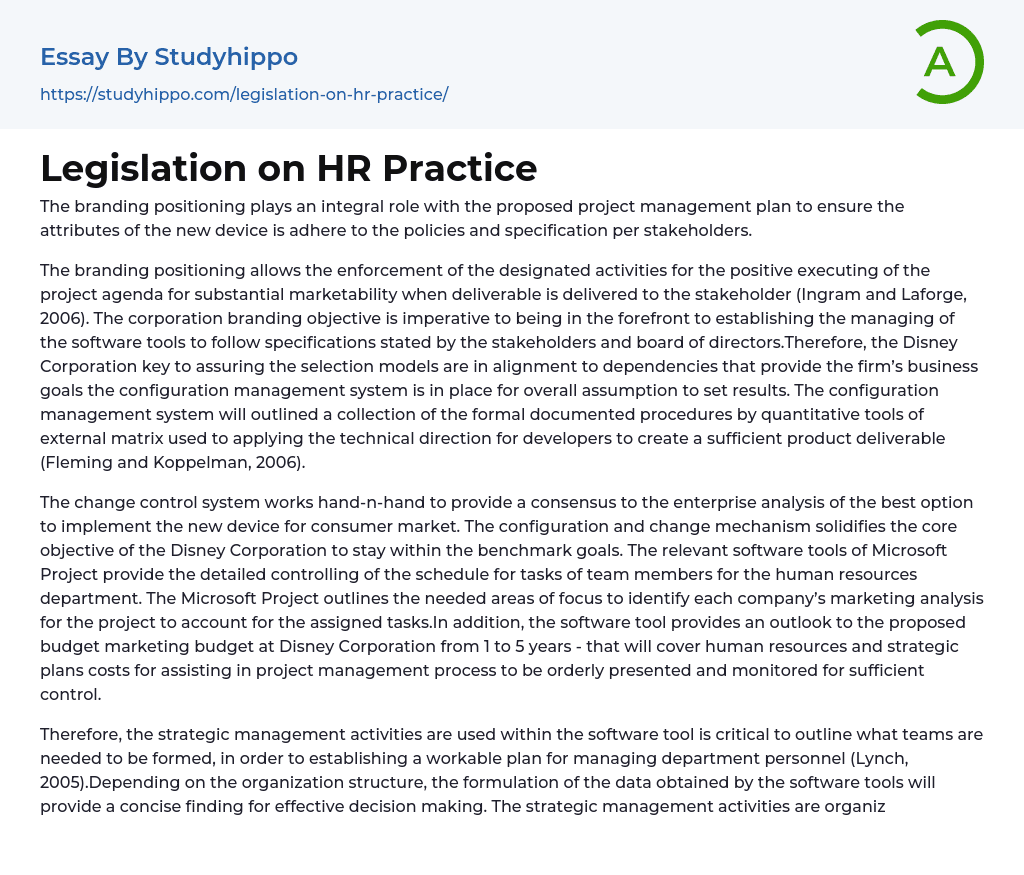In order to meet stakeholder policies and specifications, the proposed project management plan must incorporate branding positioning as a key component for the new device.
The project agenda is positively executed through branding positioning, resulting in substantial marketability upon delivery to stakeholders (Ingram and Laforge, 2006). To stay ahead, the Disney Corporation places great importance on their branding objective to effectively manage software tools in accordance with stakeholder and board of director specifications. This includes aligning selection models with necessary dependencies to achieve the firm's business goals with a configuration management system in place for desired outcomes. The development process is guided by a formal collection of documented procedures and quantitative tools, outlined by the configuration management system (Fleming and Koppelman, 2006).
The change control system and configuration and change mechanism work together to deter
...mine the best course of action for implementing a new consumer device in the enterprise. Disney aims to stay within set benchmarks and Microsoft Project software tools facilitate this goal by controlling team member schedules in the human resources department. Additionally, the software tool helps to identify each company’s marketing analysis and necessary project tasks. It also offers a projected marketing budget for Disney Corporation covering human resources and strategic costs over 1 to 5 years, allowing for orderly presentation and monitoring of the project management process.
Therefore, it is critical to use strategic management activities within the software tool to outline necessary teams and establish a workable plan for managing department personnel (Lynch, 2005). Depending on the organization structure, the software tools can provide concise findings for effective decision-making. These strategic management activities are organized within the human resources department for a
more detailed approach to achieve internal goals. The human resources department is crucial in establishing knowledgeable workers through successful recruitment, interviewing, and selection processes. The impact of equal opportunity legislation on HR practice greatly affects an organization's pursuit of highly qualified and skilled employees. Equal opportunity legislation facilitates HR practice to reach high-level recruitment and selection plans (Martocchio, 1998).
The aim of equal opportunity legislation is to make sure that organizations comply with hiring guidelines and do not discriminate, paving the way for a recruitment and selection plan that is fair to all applicants regardless of their religion, color, race, creed, national origin, sex, age, disability or political affiliation/influence. The recruitment plan seeks to attract candidates with technical skills, knowledge, communication skills, and interpersonal skills that can perform the required job tasks. Additionally, the goal is to ensure that potential candidates possess essential skills or ability to undergo training successfully to achieve the organization's core objectives and meet time constraints (Shermerhorn, 2008). Therefore, the human resources recruitment process will adhere to set criteria to ensure a streamlined effort towards conducting the necessary job duties and problem-solving attributes while adhering to the goal of equal opportunity.
To create a pool of potential candidates, human resources plans to network with local agencies for referrals and advertise open positions while listing job descriptions without salaries. This will elicit interested queries and allow HR to review and interview sufficient candidates for employee selection. The selection process will be based purely on job-related criteria from the recruitment assessment of preferred candidate attributes. HR will measure selection criteria according to equal opportunity objectives to promote fairness, diversity, and integrity. Disney Corporation is
an example of an exceptional selection protocol that incorporates the bona fide occupational requirements of positions and implements criteria for a better advantage to hiring based on organizational culture.




